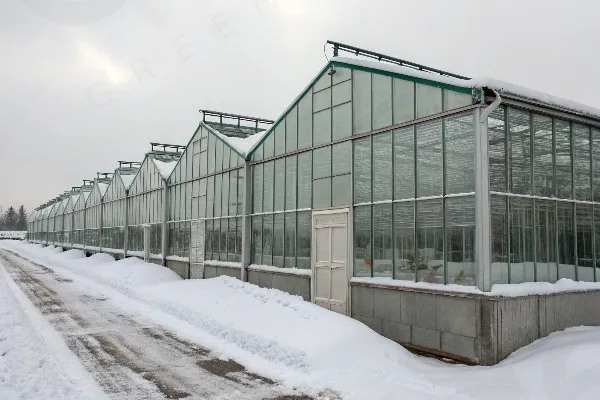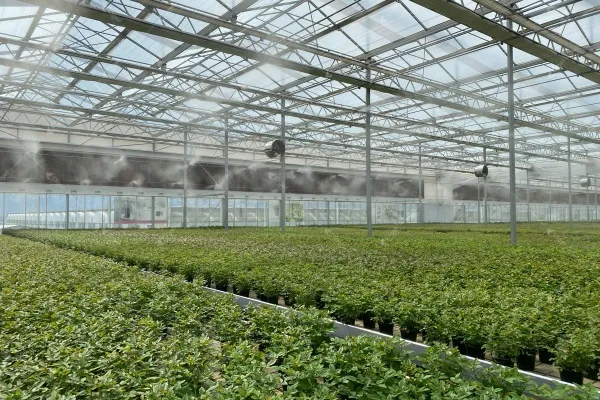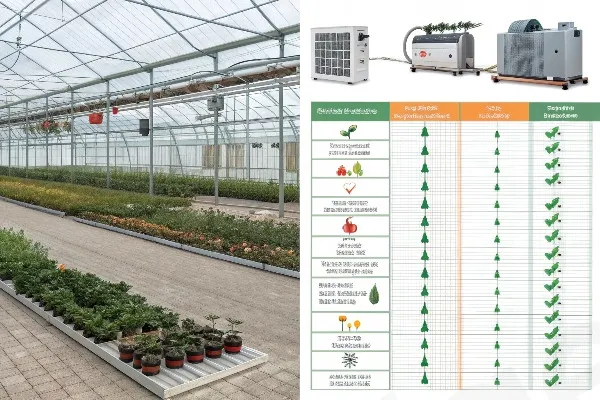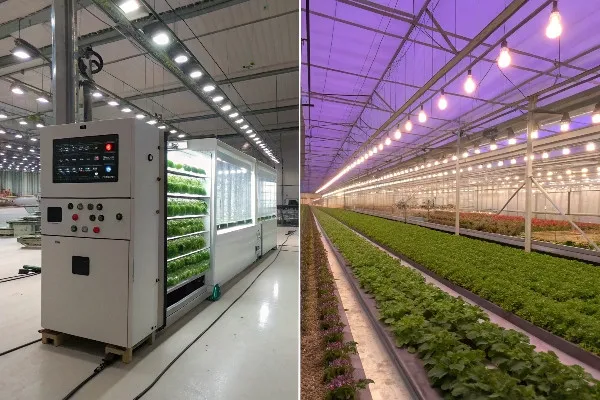Choosing the wrong irrigation system can destroy your greenhouse investment within a single growing season. Most new growers focus on upfront costs while ignoring water efficiency, labor requirements, and long-term maintenance that determine profitability.
Commercial greenhouse irrigation includes six main systems: drip irrigation for precision water delivery, micro-sprinkler systems for humidity control, subsurface drip for root zone targeting, manual pipe systems for budget operations, mobile sprinklers for flexibility, and hydroponic systems for soilless production. Each serves specific crop types and operational requirements.
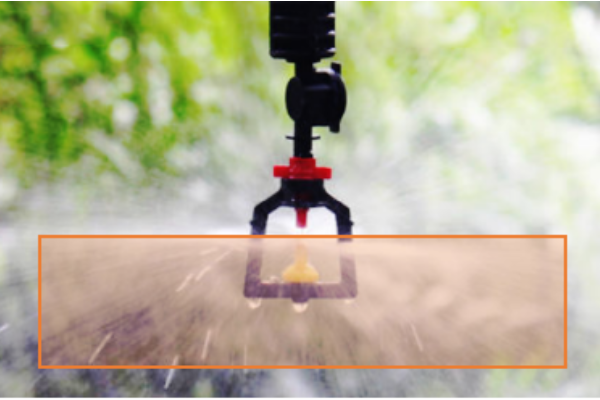
After designing irrigation systems for commercial greenhouses across 20 countries for nearly three decades, I’ve learned that the right irrigation choice determines whether your operation thrives or fails. The system you select affects everything from crop yields to labor costs to water conservation.
Key Irrigation Technologies Compared: Core Advantages and Scenarios for Drip, Micro-Sprinkler, and Subsurface Drip
These three precision irrigation technologies represent the most efficient water delivery methods for modern greenhouse production. Each system offers distinct advantages for specific growing conditions, crop types, and operational goals.
Drip irrigation provides 90-95% water efficiency with precise nutrient delivery, micro-sprinklers offer 85% efficiency with humidity control benefits, and subsurface drip achieves 95%+ efficiency while eliminating surface evaporation and disease pressure from wet foliage.
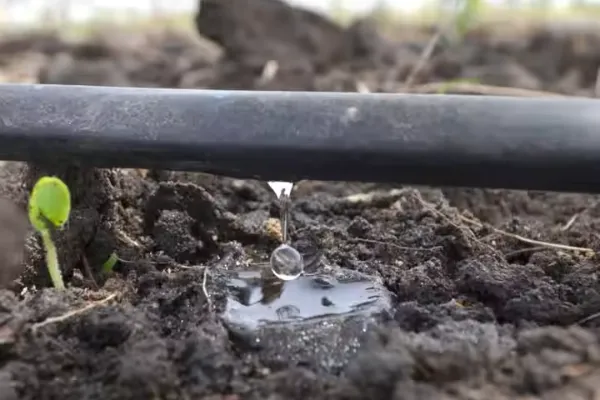
Drip Irrigation: Precision Water and Nutrient Delivery
Drip irrigation delivers water directly to plant root zones through emitters that release precise amounts at regular intervals. This targeted delivery eliminates water waste while providing optimal soil moisture conditions for maximum crop production.
The system operates at low pressure (10-30 PSI) through networks of polyethylene tubing with pressure-compensating emitters. These emitters maintain consistent flow rates regardless of elevation changes or pressure variations, ensuring uniform water distribution across large greenhouse areas.
Water efficiency with properly designed drip systems reaches 90-95%, compared to 60-70% for overhead sprinkler systems. This efficiency comes from eliminating evaporation losses, reducing runoff, and targeting water delivery to active root zones where plants can utilize it immediately.
I designed a drip system for a 5-hectare tomato operation in Spain that reduced water consumption by 40% while increasing yields by 15%. The precise nutrient delivery through the drip system improved fruit quality and extended harvest periods, generating an additional $50,000 annual revenue.
Fertigation capabilities represent drip irrigation’s greatest advantage for commercial production. Nutrients dissolve in the irrigation water and deliver directly to root zones, providing immediate plant uptake. This precision nutrition management increases fertilizer efficiency by 30-40% while reducing environmental impact.
| System Feature | Drip Irrigation | Micro-Sprinkler | Subsurface Drip |
|---|---|---|---|
| Water Efficiency | 90-95% | 85% | 95%+ |
| Nutrient Delivery | Excellent | Good | Excellent |
| Disease Prevention | Good | Poor | Excellent |
| Installation Cost | Moderate | Low | High |
| Maintenance Requirements | Moderate | Low | High |
Micro-Sprinkler Systems: Humidity and Coverage Benefits
Micro-sprinkler systems combine the precision of drip irrigation with the coverage area of traditional sprinklers. These systems use small sprinkler heads that wet circular areas 2-6 meters in diameter, providing both irrigation and microclimate control.
The dual benefit of irrigation and humidity control makes micro-sprinklers particularly valuable for crops that require high humidity levels or benefit from foliar moisture. Orchids, ferns, and many tropical plants thrive under micro-sprinkler irrigation that maintains optimal growing conditions.
Coverage patterns allow fewer irrigation points per unit area compared to drip systems, reducing installation costs and maintenance requirements. A single micro-sprinkler can irrigate the same area as 20-30 drip emitters, simplifying system design and reducing component costs.
Cooling effects from micro-sprinkler evaporation provide additional benefits in hot climates. The evaporative cooling can reduce greenhouse temperatures by 3-5°C during hot periods, reducing the load on mechanical cooling systems and improving plant comfort.
However, disease pressure increases with micro-sprinkler systems due to wet foliage conditions. Crops susceptible to fungal diseases may require careful timing of irrigation cycles to minimize leaf wetness duration while maintaining adequate soil moisture.
Subsurface Drip: Maximum Efficiency with Disease Prevention
Subsurface drip irrigation places emitter lines 15-30 cm below the soil surface, delivering water directly to root zones while keeping surface soil and plant foliage dry. This approach maximizes water efficiency while minimizing disease pressure.
Surface evaporation elimination represents the primary efficiency advantage of subsurface systems. By keeping water below ground, these systems achieve 95%+ efficiency even in hot, windy conditions where surface irrigation loses significant water to evaporation.
Root zone targeting encourages deeper root development and more efficient water uptake. Plants develop extensive root systems that access water and nutrients more effectively, leading to improved drought tolerance and overall plant health.
Disease prevention benefits include elimination of splash-borne pathogens and reduction in fungal diseases that thrive in moist surface conditions. Many high-value crops like strawberries and lettuce show dramatically reduced disease pressure with subsurface irrigation.
Installation complexity and costs exceed surface drip systems due to trenching requirements and specialized equipment. However, the long-term benefits often justify the additional investment, particularly for high-value crops or water-scarce regions.
Application Guidelines for Each System
Crop selection determines optimal irrigation technology choice. Root vegetables and row crops perform excellently with drip irrigation, while tree crops and ornamentals often benefit from micro-sprinkler systems. High-value vegetables in disease-prone environments favor subsurface drip installation.
Soil type affects system performance significantly. Sandy soils work well with all three systems but may require closer emitter spacing with drip irrigation. Clay soils benefit from subsurface drip that prevents surface crusting and improves infiltration rates.
Water quality considerations impact system selection and maintenance requirements. High-mineral water may clog drip emitters more frequently, while micro-sprinklers handle poor water quality better due to larger orifices and higher flow rates.
Climate factors influence system choice through evaporation rates, humidity requirements, and disease pressure. Hot, dry climates favor subsurface drip for maximum efficiency, while humid regions may benefit from micro-sprinklers that provide additional environmental control.
Manual Pipe vs. Mobile Sprinkler: Choices from Low-Cost to High-Automation
Manual pipe and mobile sprinkler systems represent opposite ends of the automation spectrum, offering budget-conscious operations basic irrigation capabilities while providing flexible solutions for diverse cropping systems.
Manual pipe systems cost 60-80% less than automated alternatives but require significant labor input, while mobile sprinklers provide automation and flexibility at moderate cost with 75-85% water efficiency and reduced labor requirements.

Manual Pipe Systems: Budget-Friendly Basic Irrigation
Manual pipe irrigation uses portable aluminum or PVC pipes with sprinkler heads that workers move by hand throughout the growing area. This simple system provides adequate irrigation at minimal capital cost for small to medium operations.
Initial investment for manual systems ranges from $500-1,500 per hectare, compared to $3,000-8,000 for automated alternatives. This low cost makes manual systems attractive for new operations with limited capital or temporary growing situations.
Labor requirements represent the primary operational cost of manual systems. Workers must move pipes 2-4 times daily during peak growing seasons, requiring 2-3 hours of labor per hectare per day. This labor cost can exceed $2,000 annually per hectare in developed countries.
Flexibility advantages include the ability to adjust irrigation patterns for different crops, growth stages, or seasonal requirements. Manual systems adapt easily to changing field layouts or crop rotations without expensive infrastructure modifications.
I worked with a startup flower grower in Kenya who began with manual pipe irrigation to minimize initial investment. The system served adequately for three years while the business established market relationships and generated capital for automated system upgrades.
Water efficiency with manual systems typically reaches 60-70% due to evaporation losses and imprecise timing. However, skilled operators can achieve better efficiency through careful scheduling and proper sprinkler selection.
| System Aspect | Manual Pipe | Mobile Sprinkler | Difference |
|---|---|---|---|
| Initial Cost | $500-1,500/ha | $2,000-4,000/ha | 3-4x higher |
| Labor Hours | 2-3 hours/ha/day | 0.5 hours/ha/day | 80% reduction |
| Water Efficiency | 60-70% | 75-85% | 15-20% better |
| Flexibility | High | Moderate | Manual advantage |
| Automation Level | None | High | Complete difference |
Mobile Sprinkler Systems: Automated Flexibility
Mobile sprinkler systems use self-propelled units that move automatically along predetermined paths, providing uniform irrigation coverage with minimal labor input. These systems bridge the gap between manual operations and permanent installations.
Center pivot systems represent the most common mobile irrigation technology, using rotating arms that irrigate circular areas up to 60 hectares. Linear move systems provide rectangular coverage patterns that utilize greenhouse space more efficiently than circular patterns.
Automation capabilities include programmable speed control, variable application rates, and integrated fertigation systems. Modern mobile systems can apply different water and nutrient rates to specific field zones based on crop requirements or soil conditions.
Coverage uniformity with properly maintained mobile systems exceeds 85%, compared to 70-75% for manual pipe systems. This improved uniformity leads to more consistent crop development and higher overall yields across the irrigated area.
Water efficiency improvements come from precise application timing, reduced evaporation through low-pressure operation, and elimination of human error in irrigation scheduling. Mobile systems typically achieve 75-85% efficiency through these operational improvements.
Maintenance requirements for mobile systems include regular inspection of drive mechanisms, sprinkler packages, and control systems. Annual maintenance costs typically range from $200-400 per hectare but prevent costly breakdowns during critical growing periods.
Integration with Greenhouse Operations
Greenhouse integration requires careful consideration of structural clearances and movement patterns for mobile systems. Overhead irrigation booms must clear crops, support structures, and equipment while maintaining adequate coverage patterns.
Power and water supply systems must accommodate mobile irrigation equipment through flexible connections or buried supply lines. These infrastructure requirements add to installation costs but provide long-term operational benefits.
Crop compatibility varies between manual and mobile systems based on plant height, spacing, and growth patterns. Tall crops may interfere with mobile equipment operation, while low-growing crops work well with both system types.
Environmental control integration allows mobile systems to coordinate with heating, ventilation, and humidity control systems. This coordination optimizes growing conditions while minimizing water waste and energy consumption.
Cost and Benefit Analysis: Choosing the Most Economical Irrigation Solution for Your Greenhouse
Economic analysis of irrigation systems must consider initial investment, operational costs, water savings, labor requirements, and yield impacts over the system’s useful life. The lowest initial cost rarely provides the best long-term value.
Total cost analysis shows drip irrigation provides best return on investment for most crops through 30-40% water savings, 20% labor reduction, and 10-15% yield improvements. Initial costs of $3,000-5,000 per hectare typically pay back within 2-3 growing seasons.
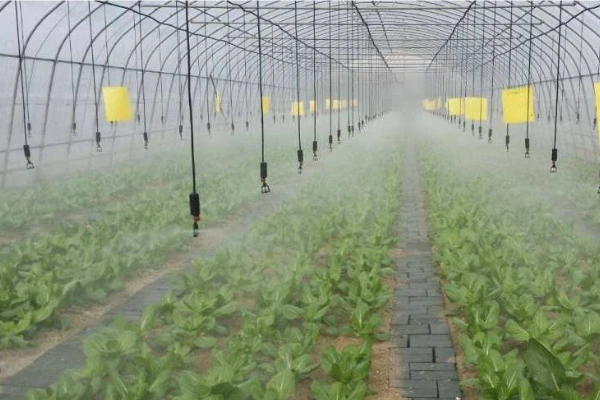
Initial Investment Comparison
Capital costs vary dramatically between irrigation system types, from $500 per hectare for basic manual systems to $8,000+ per hectare for advanced hydroponic installations. However, initial cost alone doesn’t determine economic viability.
Drip irrigation systems typically cost $3,000-5,000 per hectare including pumps, filtration, and control systems. This moderate investment provides excellent returns through water savings, improved yields, and reduced labor requirements over 10-15 year system life.
Micro-sprinkler systems cost $2,000-3,500 per hectare, offering good performance at lower initial investment. However, higher water usage and potential disease issues may increase long-term operational costs compared to drip systems.
Subsurface drip systems require $4,000-6,000 per hectare due to installation complexity and specialized components. The premium investment pays returns through maximum water efficiency and reduced disease pressure for high-value crops.
Mobile sprinkler systems cost $2,000-4,000 per hectare depending on automation level and coverage area. These systems provide good value for large operations where labor costs are significant concerns.
| System Type | Initial Cost/Ha | Annual Operating Cost | Payback Period | 10-Year ROI |
|---|---|---|---|---|
| Manual Pipe | $500-1,500 | $3,000-4,000 | N/A (baseline) | Baseline |
| Drip Irrigation | $3,000-5,000 | $1,500-2,500 | 2-3 years | 200-300% |
| Micro-Sprinkler | $2,000-3,500 | $2,000-3,000 | 3-4 years | 150-250% |
| Subsurface Drip | $4,000-6,000 | $1,200-2,000 | 3-5 years | 250-400% |
| Mobile Sprinkler | $2,000-4,000 | $1,800-2,800 | 2-4 years | 180-280% |
Operational Cost Analysis
Water costs represent a significant portion of operational expenses, particularly in arid regions where water prices continue rising. Efficient irrigation systems reduce water consumption by 30-50%, providing substantial annual savings.
Labor costs for irrigation management vary from 2-3 hours per hectare daily for manual systems to 15-30 minutes for automated systems. In developed countries, labor savings alone can justify automated system investments within 3-4 years.
Energy costs for pumping and pressurization affect all irrigation systems but impact varies based on system pressure requirements and operational schedules. Low-pressure drip systems typically use 40-60% less energy than high-pressure sprinkler systems.
Maintenance costs include component replacement, system cleaning, and periodic overhauls. Well-designed systems require 2-3% of initial investment annually for maintenance, while poor-quality installations may require 5-8% annual maintenance spending.
Fertilizer efficiency improvements with precision irrigation systems reduce nutrient costs by 20-30% through targeted application and reduced leaching losses. These savings compound annually and contribute significantly to system payback calculations.
Yield and Quality Impact Analysis
Yield improvements from proper irrigation management typically range from 10-25% depending on crop type and previous irrigation methods. These production increases often provide the largest economic benefits from system upgrades.
Quality improvements include better size uniformity, improved appearance, extended shelf life, and reduced defect rates. Premium markets often pay 20-50% more for high-quality produce, making quality improvements extremely valuable.
Harvest timing control through precise irrigation allows growers to target specific market windows and avoid oversupply periods. This market timing can increase average prices by 15-30% compared to uncontrolled harvest timing.
Crop loss reduction from improved disease control and stress management prevents catastrophic losses that can destroy entire seasons. Insurance against crop failure provides significant economic value that’s difficult to quantify but extremely important.
Financial Analysis Methods
Net present value (NPV) calculations account for the time value of money over system useful life. Most efficient irrigation systems show positive NPV within 3-5 years when properly implemented and managed.
Internal rate of return (IRR) analysis helps compare irrigation investments to alternative uses of capital. Quality irrigation systems typically provide IRR of 25-40%, exceeding most alternative agricultural investments.
Sensitivity analysis examines how changes in water costs, labor rates, and crop prices affect system economics. This analysis helps identify the most important economic factors and system selection criteria for specific situations.
Risk assessment considers the probability of system failure, crop loss, and market changes that could affect investment returns. Diversified operations with multiple crops and markets show lower risk profiles than specialized single-crop operations.
Special Recommendations for Arid Regions: Which Irrigation Systems Maximize Water Use Efficiency?
Arid regions demand maximum water use efficiency to maintain viable agricultural production. System selection must prioritize water conservation while maintaining crop productivity and economic viability under severe water constraints.
Arid region irrigation should prioritize subsurface drip (95%+ efficiency), precision scheduling systems, soil moisture monitoring, and water recycling technologies. Combined approaches can reduce water usage by 50-70% compared to conventional irrigation while maintaining or improving crop yields.
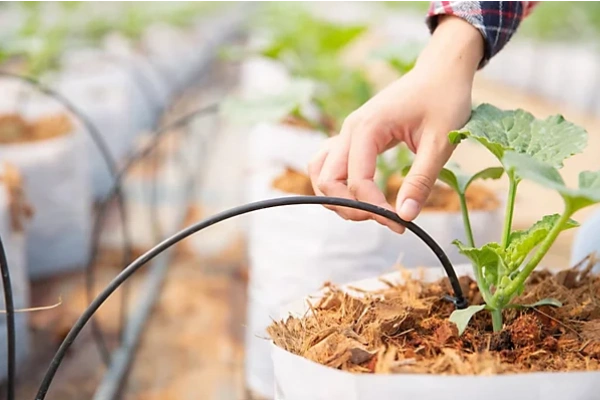
Subsurface Drip: The Ultimate Water Conservation Tool
Subsurface drip irrigation represents the most water-efficient technology available for commercial agriculture, achieving 95-98% efficiency in properly designed and managed systems. This efficiency level becomes critical in regions where water costs exceed $1,000 per hectare annually.
Evaporation elimination provides the primary water savings advantage in arid climates where surface evaporation can consume 30-50% of applied irrigation water. By placing emitters below ground, subsurface systems eliminate this major source of water loss.
Deep percolation control prevents water loss below the root zone through precise application rates and timing. Subsurface systems can apply water at rates matching plant uptake, eliminating the excess application needed with surface systems to ensure adequate root zone moisture.
I designed a subsurface drip system for a vineyard in Chile’s Atacama Desert where water costs $2,000 per hectare annually. The system reduced water usage by 60% compared to surface drip while improving grape quality and extending vine productive life.
Salt management benefits include reduced salt accumulation at the soil surface and improved leaching efficiency. Subsurface irrigation can maintain crop production in saline conditions that would be impossible with surface irrigation methods.
Installation considerations for arid regions include deeper emitter placement (20-30 cm) to encourage deep rooting and protection from surface disturbance. Specialized installation equipment may be required but the water savings justify the additional complexity.
| Water Conservation Method | Water Savings | Implementation Cost | Complexity Level |
|---|---|---|---|
| Subsurface Drip | 50-70% | High | High |
| Precision Scheduling | 20-30% | Low | Moderate |
| Soil Moisture Monitoring | 15-25% | Moderate | Moderate |
| Mulching Integration | 10-20% | Low | Low |
| Water Recycling | 30-50% | Very High | Very High |
Precision Scheduling and Monitoring Systems
Soil moisture monitoring provides real-time data on plant water needs, allowing irrigation scheduling based on actual conditions rather than estimates or fixed schedules. This precision can reduce water usage by 20-30% while improving crop performance.
Tensiometers measure soil water tension at multiple depths, providing direct indication of plant water stress levels. These simple devices cost $50-100 each but can save thousands in water costs through improved irrigation timing.
Electronic monitoring systems using capacitance or time-domain reflectometry sensors provide continuous soil moisture data that can be integrated with automated irrigation controls. These systems cost $200-500 per monitoring point but provide superior precision and convenience.
Weather-based irrigation scheduling uses evapotranspiration calculations to determine daily water requirements based on temperature, humidity, wind, and solar radiation. This approach works well in arid regions with predictable weather patterns.
Plant-based monitoring through leaf temperature sensors or sap flow measurements provides direct indication of plant water stress. These advanced techniques require specialized equipment but offer the most precise irrigation timing possible.
Deficit irrigation strategies deliberately stress plants during specific growth stages to improve water use efficiency without significantly reducing yields. This approach requires careful monitoring and expertise but can reduce water usage by 25-40% for many crops.
Water Recycling and Reuse Technologies
Closed-loop hydroponic systems recycle nutrient solutions continuously, achieving near-zero water waste while providing optimal plant nutrition. These systems require higher initial investment but eliminate water waste entirely.
Drainage water recovery systems collect and treat runoff from conventional irrigation for reuse. Treatment may include filtration, disinfection, and nutrient adjustment to maintain water quality for crop production.
Condensate recovery from greenhouse cooling systems can provide significant water supplies in arid regions. Evaporative cooling systems produce 5-10 liters of condensate per square meter daily, which can supplement irrigation supplies.
Greywater treatment systems process water from washing operations, equipment cleaning, and other non-potable sources for irrigation use. Proper treatment ensures crop safety while maximizing water resource utilization.
Rainwater harvesting becomes particularly valuable in arid regions where infrequent rainfall can provide substantial water supplies when properly collected and stored. Storage systems require significant investment but provide drought insurance.
Integration Strategies for Maximum Efficiency
Multi-zone irrigation systems allow different crops or growth stages to receive precisely matched water applications. This zoning approach prevents over-watering some areas to ensure adequate moisture in others.
Mulching integration with efficient irrigation systems reduces evaporation losses by 50-80% while suppressing weeds that compete for water. Organic or synthetic mulches work well with subsurface drip systems.
Crop selection for arid regions should emphasize drought-tolerant varieties and species that provide good economic returns with limited water inputs. Native and adapted crops often perform better than water-demanding exotic species.
System automation reduces human error and ensures optimal irrigation timing even when skilled operators are unavailable. Automated systems can respond to changing conditions 24 hours daily, maximizing water use efficiency.
The combination of efficient irrigation technology, precision monitoring, and integrated water management can maintain profitable agriculture even in extremely water-scarce environments. Success requires initial investment in quality systems and ongoing commitment to efficient management practices.
Conclusion
Commercial greenhouse irrigation success depends on matching system capabilities to crop requirements, operational constraints, and economic goals. Efficient systems provide excellent returns through water savings, improved yields, and reduced labor costs over their operational life.

